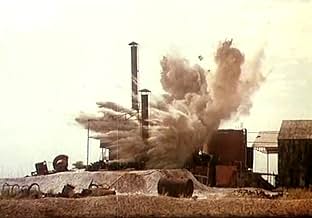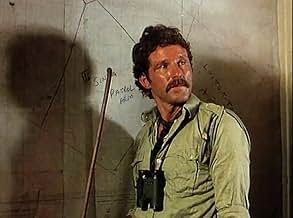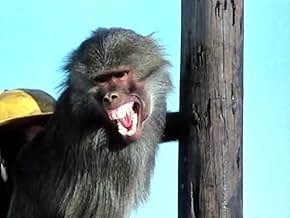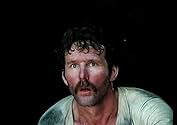Agrega una trama en tu idiomaBecause of a severe drought in Kenya in 1984, ninety thousand starving baboons go on a murderous rampage, killing humans and animals alike.Because of a severe drought in Kenya in 1984, ninety thousand starving baboons go on a murderous rampage, killing humans and animals alike.Because of a severe drought in Kenya in 1984, ninety thousand starving baboons go on a murderous rampage, killing humans and animals alike.
- Dirección
- Guionistas
- Elenco
Carl Vundla
- District Officer Tshombe
- (sin créditos)
- Dirección
- Guionistas
- Todo el elenco y el equipo
- Producción, taquilla y más en IMDbPro
Opiniones destacadas
We've certainly seen our share of killer primate movies. From 'Monkey Shines: An Experiment in fear' to 'Link', 'Shakma' and 'In the Shadow of Kilimanjaro'. (I'm not mentioning 'Congo' and 'King Kong' here because they weren't real animals). 'In the Shadow of Kilimanjaro' is undoubtedly one of the most realistic and terrifying of all.
Based on fact, the film depicts the moment when thousands of baboons turned to humans as food substitute during a drought. Entirely filmed on location in Kenya, this adds to the realism of the movie (so sad to think 'filmed on location' will soon be a thing of the past with the ever-growing use of CGI...).
Timothy Bottoms stars as ranger Jack Ringtree, whose wife Lee (Irene Miracle) comes to visit him begging to come home. Her timing couldn't have been worse, as all hell is about to break loose. Nearby, a mining company run by Chris Tucker (John Rhys-Davies) encounters several problems while running out of contract time, but things are about to get much worse as the baboons descent on the small town.
The attack scenes are brutal, realistic and simply terrifying. The use of real baboons makes it all the more scarier and the suspense is nail-biting. This is the stuff nightmares are made of!
'In the Shadow of Kilimanjaro' is one of my all-time favourite and most memorable 80's horror films.
Would I watch it again? Absolutely!
Based on fact, the film depicts the moment when thousands of baboons turned to humans as food substitute during a drought. Entirely filmed on location in Kenya, this adds to the realism of the movie (so sad to think 'filmed on location' will soon be a thing of the past with the ever-growing use of CGI...).
Timothy Bottoms stars as ranger Jack Ringtree, whose wife Lee (Irene Miracle) comes to visit him begging to come home. Her timing couldn't have been worse, as all hell is about to break loose. Nearby, a mining company run by Chris Tucker (John Rhys-Davies) encounters several problems while running out of contract time, but things are about to get much worse as the baboons descent on the small town.
The attack scenes are brutal, realistic and simply terrifying. The use of real baboons makes it all the more scarier and the suspense is nail-biting. This is the stuff nightmares are made of!
'In the Shadow of Kilimanjaro' is one of my all-time favourite and most memorable 80's horror films.
Would I watch it again? Absolutely!
Some of the reviews I encountered on "In the Shadow of Kilimanjaro" complain that baboons aren't convincing and not nearly menacing enough to pass for murderous animals. Well, this is a false impression in general. During a recent trip to South Africa I made a couple of excursions and the first thing the tour guides always warn you for are wild baboons. They are extremely aggressive animals and if they spot people with food in their hands, they will relentlessly attack and steal it from them. I'm not familiar with the supposedly true event this movie is based on, but I find it to be quite plausible and – even in case it never happened – it's a terrific plot outline for a mature and intellectual eco-horror movie anyway. The year is 1984 and Kenya, as well as the majority of the African continent, slowly cringes under a severe drought. It hasn't rained in months, the wildlife deteriorates, the animals are dying and a local community of mine workers do whatever they can to survive. They suddenly face an even more overpowering ordeal when all the baboons in the area, approximately 90.000, herd together and launch spontaneous attacks against the humans in their quest for food. "In the Shadow of Kilimanjaro" is a fairly odd and unusual 80's horror movie, since it doesn't aim for mindless shocks or bloody set-pieces, but merely thrives on atmosphere and educational values. The first half hour is really slow and moody, but this is mostly done to illustrate the atmosphere of drought and despair they characters find themselves trapped in. Once the baboons go on their virulent murder sprees, the film becomes more adventurous and horrific (with images of ripped off limbs and half-eaten faces) but still the violence never becomes gratuitous or overly exploitative. The make-up effects are effective and big kudos to the animal trainers, because a lot of footage was filmed using real animals. The mechanical baboons, used during the more complicated attack scenes, are definitely convincing as well. This mainly African-produced film features two international stars delivering more than adequate performances, namely Timothy Bottoms as a park supervisor (and kind of looking like a big ape himself, what with the ferocious beard) and John Rhys-Davies as the demanding mine owner. "In the Shadow of Kilimanjaro" is a good and original film, naturally benefiting the most of the wonderful scenery and exterior filming locations, but also boosting a unique storyline and multiple moments of great suspense.
A ridiculous story of a drought in Africa which results in 90,000 baboons deciding to attack humans as their only way of getting food. Yes, that's right, 90,000 red-assed baboons munch their way through the cast during this silly 97 minute horror flick. There's a fair bit of needless gore, which doesn't help, and lots of build ups which peter out without delivering an exciting or frightening pay-off. The only decent thing about this movie is John Rhys-Davies (who was so great in Raiders of the Lost Ark), who injects a bit of interest in a somewhat underwritten role.
Michele returned to Hollywood for one final appearance after a short hiatus to raise her son as he was a high school student at the time of the films production.
Michele was excited to travel to Kenya for the filming but was disappointed with its final presentation.
Michele officially retired from acting within days of returning to her home in California.
Michele passed away on November 21st, 2018 at the age of 75 having never returned to her acting career.
Michele was excited to travel to Kenya for the filming but was disappointed with its final presentation.
Michele officially retired from acting within days of returning to her home in California.
Michele passed away on November 21st, 2018 at the age of 75 having never returned to her acting career.
The basic plot of IN THE SHADOW OF KILIMANJARO (1986) is that an army of crazed, homicidal babboons are killing folks left and right in the middle of nowhere. The thing the filmmakers should of realised is that babboons always look kind of bored. An example comes in one scene where a movie character has a flat tire in the desert. We cut to shots of yawning, pre-occupied looking monkeys watch him from afar. They seem to be saying "Hoo-Hummm, I dunno, should I kill him? I don't know, rather sit here and pick flies off my fur. (Yawn....) Okay. Let me go down and kill 'em." We had a good laugh with this one.
¿Sabías que…?
- Trivia[Postscript] The film you have just seen is a fictionalized account of a true incident which took place in Africa during the serious drought in 1984. The producers wish to make it known that not a single animal was mistreated during the making of this motion picture. On completion of filming the Baboons were rehabilitated to their natural surroundings. The Baboons were captured under the supervision of the Kenyan Ministry of Tourism and Wildlife from the areas where they had been a nuisance to the local population.
- Créditos curiosos[Postscript] The film you have just seen is a fictionalized account of a true incident which took place in Africa during the serious drought in 1984. The producers wish to make it known that not a single animal was mistreated during the making of this motion picture. On completion of filming, the Baboons were rehabilitated to their natural surroundings. The Baboons were captured under the supervision of the Kenyan Ministry of Tourism and Wildlife from the areas where they had been a nuisance to the local population.
- ConexionesFeatured in Trailer Trauma 3: 80s Horrorthon (2017)
- Bandas sonorasIn the Shadow of the Kilimanjaro
Words and Music by Chieli Minucci & Allan Smallwood
Selecciones populares
Inicia sesión para calificar y agrega a la lista de videos para obtener recomendaciones personalizadas
- How long is In the Shadow of Kilimanjaro?Con tecnología de Alexa
Detalles
Taquilla
- Total en EE. UU. y Canadá
- USD 181,410
- Fin de semana de estreno en EE. UU. y Canadá
- USD 181,410
- 11 may 1986
Contribuir a esta página
Sugiere una edición o agrega el contenido que falta

Principales brechas de datos
By what name was In the Shadow of Kilimanjaro (1985) officially released in Canada in English?
Responda


























